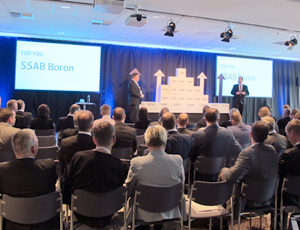Nordic Steel Day 2016 held in Helsinki
The event kicked off with an interview where Jouni Rättyä, Director, Sales Nordic, Finland and Baltics SSAB Europe interviewed divisional head Olavi Huhtala. In answer to the question of whether integration has now been completed, Huhtala said that he was generally pleased with the progress made in the combination of SSAB and Ruukki, and that most of the synergy projects will have been completed by the summer.
The sites are specializing and products are being harmonized. Specialization enables the sites to focus on developing certain products and makes investments easier. Products can be made at two sites to enable flexibility in customer shipments where needed.
“When someone begins thinking about steel, I want them to think that we are their best choice on all scores. We are also close to customers on our home markets. Collaboration is important and, for example, our technical customer support can help customers to choose the right materials and advise them in technical questions,” said Olavi Huhtala.
“The environment and sustainability are important to SSAB. In April this year, SSAB, LKAB and Vattenfall announced the launch of a joint initiative to develop a steel production process that emits water instead of carbon dioxide,” said Olavi Huhtala.
Steel – and the world around us
Thomas Hörnfeldt, Vice President of Sustainability and Public Affairs, noted that climate change, population growth and urbanization would drive future demand for steel.
Steel is the world’s most recycled material and scrap metal accounts for a third of the raw material in steel production, which also requires iron ore.
SSAB uses 40% of scrap steel in its steel production, whereas the average is 30%.
SSAB’s iron-ore-based steel production is around 7% more efficient than the European average. This means 600,000 tonnes less CO2 emissions each year.
“If we take heavy trucks, around 10% of the environmental impact originates during the production process and 90% during product use. If our customers are able to use our steels to make a 10%-lighter truck, this reduces fuel costs by 5%,” said Thomas Hörnfeldt.
Optimized steel range – SSAB product families
In April, SSAB launched five product families - SSAB Domex, SSAB Boron, SSAB Form, SSAB Laser Plus and SSAB Weathering. Technical development managers Erkki Krankkala, Juha Tuomisto and Sami Nummela from Technical Customer Support went through the properties and applications of the different products. SSAB’s product families share a number of characteristics: purity of the steel, consistent properties from one shipment to the next, and they all conform with and exceed the requirements of the relevant standards. Link to ssab.com site.
An example of successful customer collaboration – Ab. A. Häggblom Oy
This year, the customer guest speaker at the Nordic Steel Day was purchasing director Jukka Oravainen from Ab A. Häggblom Oy in Kokkola. The company is Northern Europe’s leading manufacturer of track applications and customized large buckets for, among others, the mining industry and a supplier of spare and wear parts for earthmoving machinery.
“We focus on a narrow sector, where good partners are required from a broad spectrum. We are committed to quality components and the world’s leading brands,” said Jukka Oravainen.
“We compete purely on quality and the component materials must be exactly as promised to the customer. We are a member of the Hardox in My Body and Hardox Wearparts programs , which guarantees to end users that Hardox steel has been used in products.”
“We have long experience of both Ruukki’s and SSAB’s products. Now that the companies have merged, we have just one partner with whom we can focus on developing our products,” Jukka Oravainen stated.
Jukka Oravainen considered the presentations of the range of SSAB’s branded products to be useful. “SSAB’s products have a key role in our marketing. Their qualities also reflect directly in the properties and manufacturing processes of our own products. ”
Customer comments about the event
HT Laser Oy makes machine parts from SSAB’s special steels for its customers, who include manufacturers of forest machines and cargo handling equipment.
“It was useful to hear more about SSAB’s new product families. The presentation about the future use of steel was also interesting,” said Jukka Teiskonen HT Laser’s managing director. “These types of events are also excellent forums to meet acquaintances and to talk with people in the industry,” Jukka Teiskonen added.
Treston Oy uses SSAB’s cold-rolled steels in sheet, strip and tube form in the manufacture of furnishings such as industrial work benches, drawer units and cupboards. For consumers, Treston makes storage furniture, such as Sovella storage systems.
“We have had a longstanding, trusted close collaboration dating back to the Ruukki days. It was interesting to hear the update by SSAB’s management about the progress in the combination of SSAB and Ruukki. The presentation on sustainability and the future use of steel was interesting,” said Mikko Ahonen, Director, Jyväskylä Plant & Sourcing.
“These events also provide good examples of the suitability of different steel grades in different applications. This is something that can also be useful to take back to the company’s own production,” Mikko Ahonen adds.
Work, productivity and digitalization in a changing Finland – lecture by Ilkka Halava, researcher into the future
Ilkka Halava, researcher into the future, spoke on the topic of Work, productivity and digitalization in a changing Finland. According to him, we are in a transition stage and at the start of a 30-year period, and we need to understand what the change implies. System changes are on the way, for example, in transport, production, energy, trade and food production.
In future, we will begin to transport more raw materials instead of ready products. 3D-printing will increase and production will become localized. Trucks will operate without drivers. In food production, vertical farming will appear alongside traditional outdoor farming. In cities, multilayer and led cultivation will be used in vertical farming in interior areas.
“Digitalization will make earlier impossible things possible for mankind,” Ilkka Halava said.
